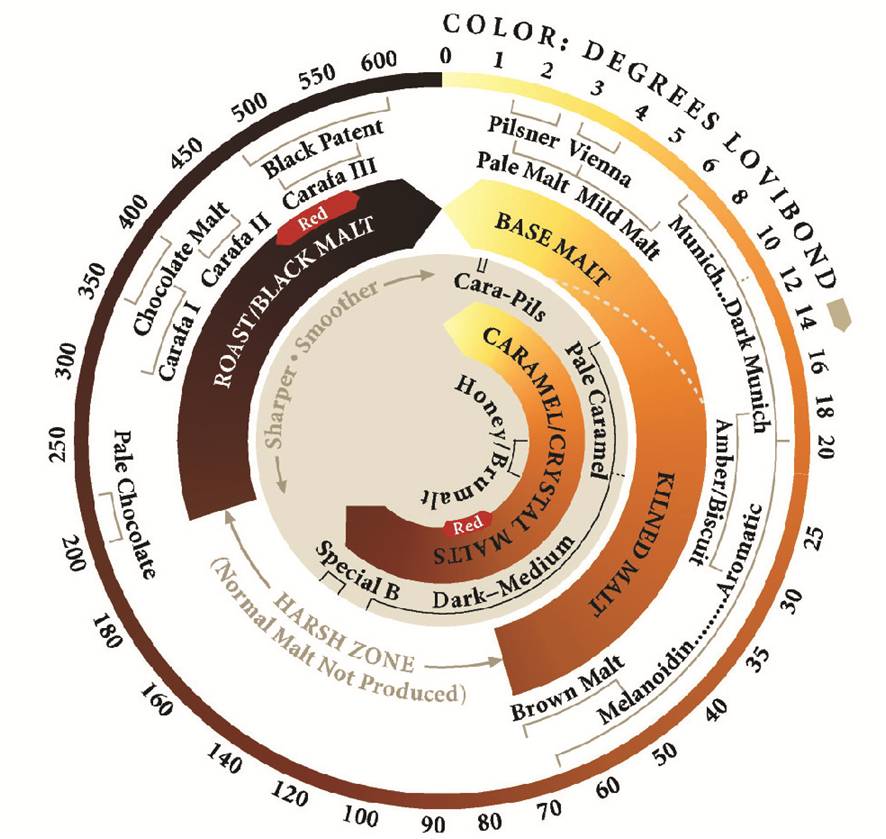
This week I take a close look at malts, the four major malt groups and how malts are best used in beer brewing. This is a summary article which incorporates links to more detailed articles on each malt group.
The Four Major Malt Groups
All of the barley malts used in brewing can be effectively broken into four groups: base malts, kilned malts, caramel/crystal malts and roasted malts. Randy Mosher published the chart on the top right in his book Mastering Homebrew and I think it is a very effective way to think of the four major groups.
Malted barley is made from raw barley by germinating the seed, allowing it to grow for a few days and then drying it in a kiln. It then may be further toasted or roasted to produce various colored and roast malts. The malting process breaks down long carbohydrate chains into less complex sugars that are then further broken down during the mashing process into sugars like maltose that can be easily fermented.
An important observation which Randy made in his book is that very few malts are produced in the color range between 70 L and 200 L. This area, which he called the “harsh zone” produces malts with harsh burnt flavors like burnt toast, burnt marshmallow, and excessive tannins. You can read more about the harsh zone here, but in general you should use malts in and around this zone sparingly as the harsh flavors can be dominating.
Malt Groups Flavor and Use
I’ve written detailed articles on each of the malt groups which are linked in this section, and I encourage you to read up on these by clicking on the linked article if you want to understand the flavor and use of each malt:
- Base Malts – Base malts should make up the vast majority of your malt bill. The provide the bulk of fermentables and also malty sweetness, and some cracker flavors. More distinct base malts like Munich or Maris Otter can also add significant character to a beer.
- Caramel/Crystal Malts – Caramel and Crystal malts are widely used in English ales, stouts and porters. They provide color, body and sweetness to the beer and also provide a lot of the fruity flavors like plums, figs and pears that we associate with English styles. They are, however, sometimes overused by brewers when other malts like kilned malts might be more appropriate. Dark crystal malts can also be very harsh, so they should be used sparingly.
- Kilned Malts – Kilned malts provide color, body, and flavor much like Caramel/Crystal malts but lack the fruity flavors of crystal. They are widely used in virtually any style where you want a malty or toasted finish without fruit. Darker kilned malts like brown malt can also be harsh, so they should be used sparingly.
- Roasted Malts – Roasted malts are the darkest malts used in brewing mostly dark styles like Porters and Stouts. They vary in flavor from the harsher light chocolate to the coffee like black and stout roast malts. They provide almost no fermentables but do add body, color and a strong roasted flavor.
For a more detailed discussion of the individual malts, their flavors and also their use in specific styles I recommend you click on the detailed article for the malt group above. Also, my post on the harsh zone malts is a must read for anyone who wants to understand which malts are most likely to impart harsh flavors into your beer.
I hope you enjoyed this summary article on malts. Thank you for joining me on the BeerSmith Home Brewing Blog. Be sure to sign up for my newsletter or my podcast (also on itunes…and youtube for more great tips on homebrewing.